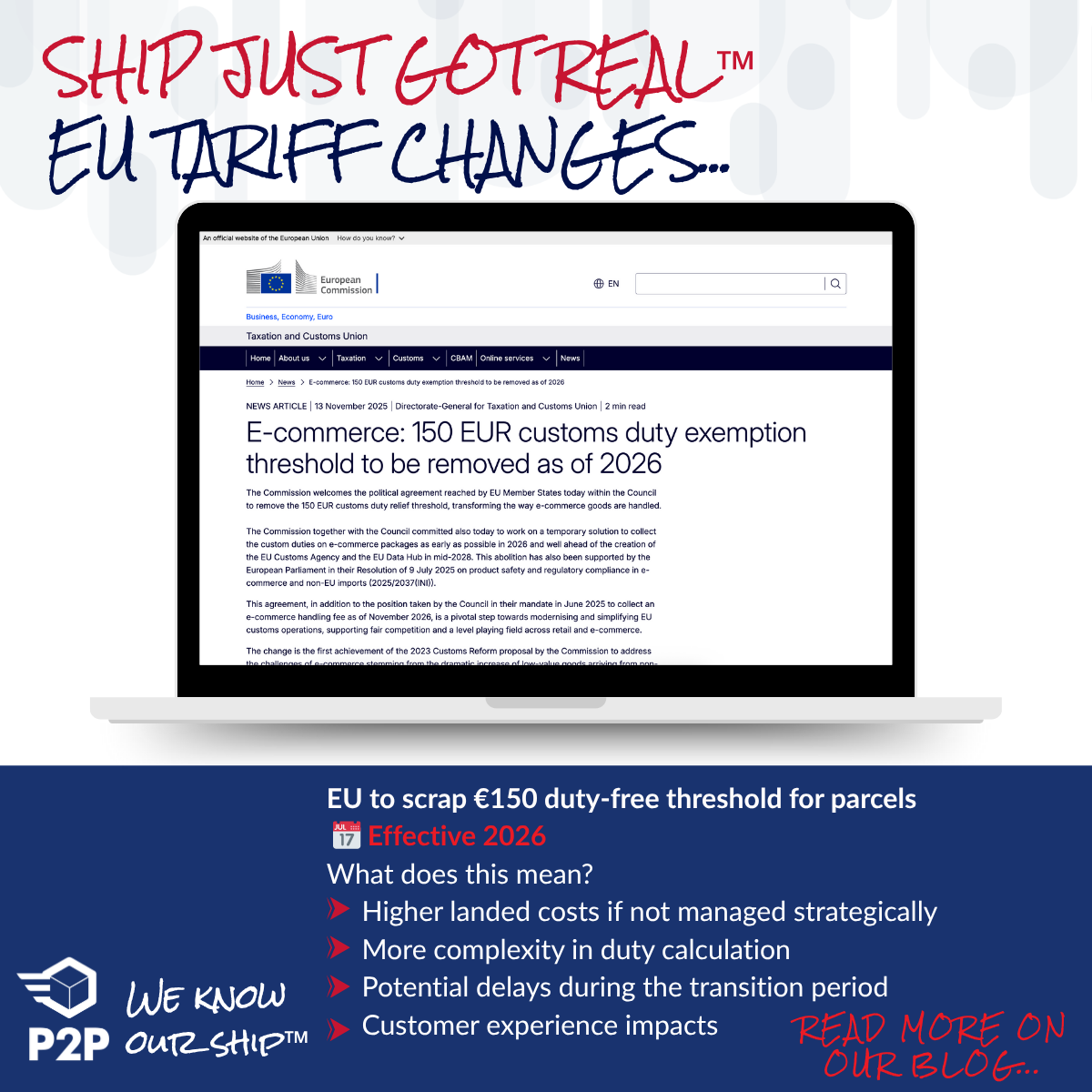The rules of cross-border e-commerce are changing, again. For brands shipping into the EU, ship’s about to get real™ in 2026.
EU Member States have reached a major agreement to remove the long-standing 150 EUR customs duty exemption for goods shipped from non-EU countries to EU consumers. This move is part of a wider, fast-tracked customs reform designed to modernize the system, close loopholes, and create a level playing field between traditional retailers and the booming e-commerce import market.
Here’s what’s changing and how Point2Point Global can help you navigate what’s next.
Why the EU Is Removing the 150 EUR Duty Threshold
For years, parcels valued under 150 EUR skipped customs duty, even though VAT and declarations still applied. But with the explosion of global e-commerce, this model created unfair competition between:
- E-commerce brands shipping low-value parcels directly to consumers, and
- Retailers importing bulk goods under traditional customs rules
The EU has decided the exemption no longer reflects how people shop or how global supply chains actually move. By removing the threshold, EU regulators aim to:
- Level the playing field for all retailers
- Improve transparency in duty collection
- Reduce exploitation of low-value exemptions
- Modernize customs data and processes
This marks the first major milestone of the EU’s 2023 Customs Reform initiative.
When Are These Changes Happening?
The reforms will roll out much sooner than originally planned, due to pressure from surging e-commerce volumes:
- Duty exemption removed: Early 2026
- Temporary duty calculation method implemented: Early 2026
- E-commerce handling fee introduced: November 2026
- EU Customs Agency & Data Hub live: Mid-2028
Long story short: Brands need to prepare now.
What This Means for E-Commerce Shippers
Once the exemption is removed, every cross-border shipment—no matter its value—may be subject to customs duty. That means:
- Higher landed costs if not managed strategically
- More complexity in duty calculation
- Potential delays during the transition period
- Customer experience impacts if fees are not handled transparently
The EU will adopt a temporary streamlined method for duty calculation until the full Customs Data Hub comes online in 2028—but even “simple” changes come with operational ripple effects.
How P2P Helps You Stay Ready for 2026
At P2P, we know our ship™ when it comes to cross-border compliance, customs changes, and keeping your customers happy, no matter what regulators throw at you. Here’s how we help brands prepare for the new EU rules:
1. Smarter Duty & Tax Modeling
Our SETA platform’s real-time logic ensures you get accurate landed-cost calculations—even as rules shift.
2. Flexible Cross-Border Solutions
Our global network of 200+ carriers helps you adapt routing, delivery options, and clearance strategies based on evolving requirements.
3. Customs Guidance That Keeps Ship Moving
We help you evaluate:
- Whether Type 11 or alternative clearance solutions fit your model
- How to optimize returns workflows
- How to limit unnecessary handoffs or surprise fees
4. Proactive Change Management
2026 will come fast. We’re helping brands build a roadmap now so they don’t absorb unexpected costs later.
What You Should Do Next
Start scenario planning now. Evaluate your landed-cost strategy. Review your shipping and returns flows. And talk with your logistics partners (hi 👋) about how to stay compliant and competitive.Because if there’s one thing we know, it’s this: Cross-border success isn’t about resisting change, it’s about staying ready for it.
📩 Let’s shoot the ship™about how we can help your brand get ahead of the 2026 EU reforms.
